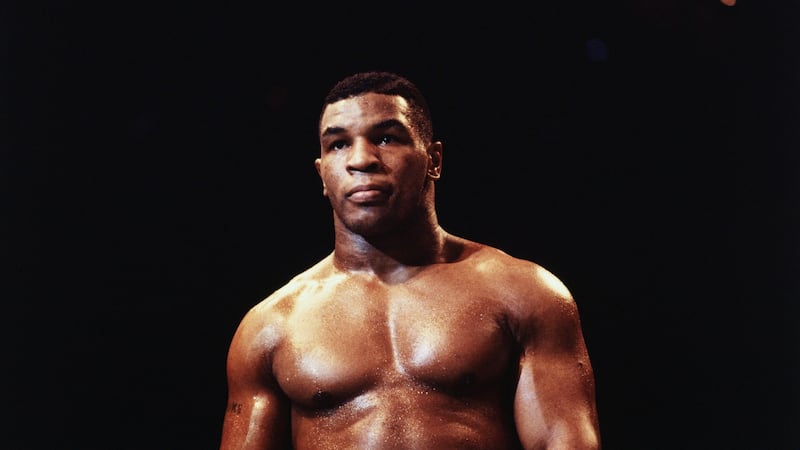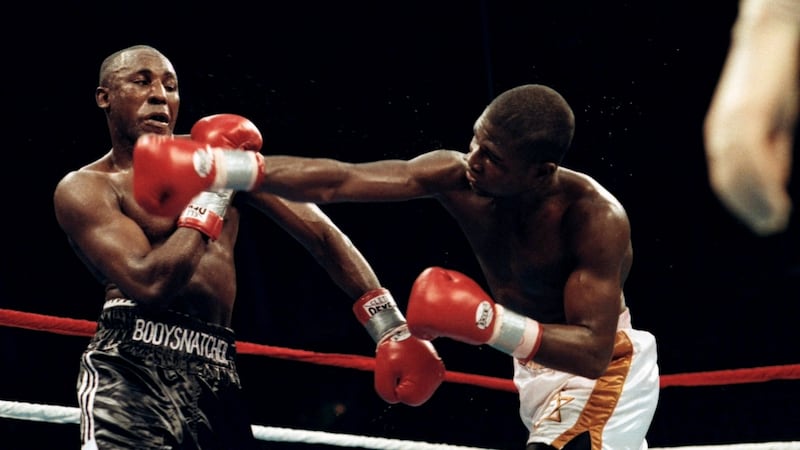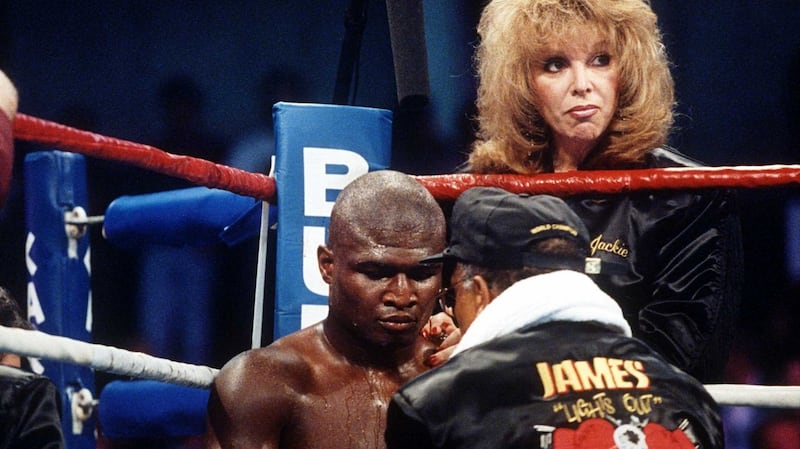June 1991 and Donald McRae found himself alone on the outskirts of Las Vegas. Excited, uncertain, anxious he stood under a burning sky, the desert sun melting the asphalt and baking the patch of waste ground near a nondescript blue and yellow tin building. He was waiting for "the baddest man on the planet" to arrive.
The "Golden Gloves" painted on the gym told him he was in the right place. McRae was there to speak to Mike Tyson. He had no appointment, no arrangement, and was relying on a previous meeting with the heavyweight in the New York Catskills years before that he thought might get him beyond a warning snarl.
It was three weeks before the July rape of 18-year-old beauty from Coventry, Rhode Island, Desiree Washington, for which Tyson would be sentenced to six years in prison and serve three.
Already newspaper reports had been indicating he was spinning out of control. The week before he had destroyed a $20,000 lens on an ABC network camera with a “get outta my face you fuck” .
Tyson’s second fight against Donovan “Razor” Ruddock in The Mirage would take place at the end of June, the first having ended in controversy when he landed a six-punch combination on Ruddock and the referee stopped the contest. This time in the build-up, Tyson was antsy and bellyaching about unfinished business. He had also acquired a designed to offend mantra for Ruddock. “It doesn’t count if he isn’t dead.”
As McRae is waiting a car pulls up to the building and stops. Doors are flung open. The music blasting out is the Public Enemy rap Don’t Believe the Hype. Tyson steps out, stretches his arms. He rolls his head and walks towards the stranger.
“He stared at me, his small eyes dark and clouded,” says McRae in his award-winning 1996 book Dark Trade. “Suddenly Mike Tyson moved towards me, reminding me of a giant hammerhead swerving in for the kill.”

He gives McRae a friendly punch on the shoulder and walks on, his entourage following, the doors of the gym slamming closed behind them, leaving the stranger standing alone again in the simmering air and settling dust.
“He had no idea who I was. It was at the height of his infamy,” says McRae. “There were so many people around him. It was like a Tuesday afternoon and I got lucky, I did get into the gym. I watched him spar.
“It was intimidating then to see how hard he was hitting. I felt scared. But after I summoned up courage and went over to him. Then he exploded all the myths I had. He sat down and started talking in long looping sentences quite beautifully. But also quite disturbingly about, I guess, mental health, about how he felt sometimes and how fucked up boxing was.
Two sides
“We had a long, long conversation. That was the impetus for the book. I think it was important because after that he goes to jail and the book is also, in a way, pursuing Tyson again.
“I definitely had an awareness there was two sides. There was the guy who was unhinged but also an intelligent side to him and quite articulate.
“I wasn’t the first person to stumble on that side of Tyson, so I knew it existed. Actually, I got a deluge of amazing insight and openness from him. I was lucky that day he was in a mood. He wanted to talk.”
Ominously titled, Dark Trade is the book of a white South African writer and dark skinned athletes, some with dark pasts, others facing dark futures. Looking beyond Las Vegas glitz to examine the business, personalities and mind set of the boxing trade and the boxers, it emerges as a world of contradictory and corrupt figures, a world of violence in and outside the ring, a world of deceit and destruction and of compassion, of grace and poignancy.
Tyson joins a list of damaged goods and gods. Muhammad Ali is there with Frank Bruno, Chris Eubank, Nigel Benn, Michael Watson, Oscar De La Hoya, Naseem Hamed and James Toney, many of them cautionary tales on the financial and physical perils of the sport. Damningly, also how few emerge intact. Dark Trade.

Tyson is the opening chapter in McRae’s obsessive tale, his conflicted love affair with the sport. It is also the book that almost stopped dead in its tracks. After a brutal WBO super-middleweight title fight in 1991, the second meeting between Eubank and Watson in London’s White Hart Lane, McCrae briefly walked away.
Collapsed
Eubank, having climbed off the canvas in the 11th round, connected with a savage uppercut, which caused Watson to fall back and hit the back of his head against the ropes. Referee Roy Francis stopped the fight in the 12th round, after which Watson collapsed in the ring.
There was no ambulance or paramedics. Doctors wearing dinner jackets arrived after eight minutes. In that time Watson was given no oxygen. It was 28 minutes before he received treatment in a hospital. He spent 40 days in a coma. He had six brain operations to remove a blood clot, leaving him with irreparable brain damage and partially paralysed.
“I came as a fan. I think that comes over. I’m quite in awe,” says McRae. “I knew I wanted to do a book that captured my ambivalent feelings towards boxing. The deeper I got in, the ambivalence became more and more stark.
“Nigel Benn against (Gerald) McClellan is perhaps the most savage fight in the book. It was such a disturbing fight. But one that had us totally compelled. McClellan, it left him blind, partially deaf, severely brain damaged. Also, almost 30 years later he is a shuffling shadow of himself.
“When you are exposed to fights like that it forces you to examine even more closely your absorption in boxing. The Watson fight affected me because I knew him and I spent a lot of time with him.
“The next morning, when I understood what had happened to him, I felt I cannot go on with this, not only abandon the book but also abandon my love of the sport. James Toney pulled me back in. I went back to my South African past, I guess. I was fascinated by this young black man with his white manager and how that was working, a suburban Jewish woman.
"That got me thinking what's going on here between James Toney and Jackie Kallen. I fell back into boxing. There were many other occasions in that book where fighters were hurt. But I still continued. Even today. It just keeps pulling me back."

Knockout machine
It was "Lights Out" Toney, who gave McRae more access than he could have imagined. In 1993 Toney was the coming force in boxing. Tyson was in prison and Toney, out of Detroit, was a knockout machine and seamlessly stepped in to Tyson's place as the sport's malevolent force. He was a former gun-carrying, crack dealer and on his way towards becoming the best pound for pound fighter in the world.
As a child his father had shot his mother Sherry and left her for dead, a life’s start that would steer Toney towards violence and criminality. It was Sherry who turned him towards boxing, believed focussing the disordered rage of her son might save his life.
What struck McRae when they met was the women who surrounded him, Toney’s then girlfriend, his manager and his mother. Together they created an environment that diffused the simmering aggression.
“The thing that beguiled me is that when I first met him he was surrounded by women. His mother was the most important person in his life. His manager was this white Jewish woman. He had his fiancé at the time and his baby girl,” says McRae.
“A phalanx of all females. It didn’t quite jell with this hardcore guy who was going to stand there and blow your head off. They were fussing over him, keeping him in line. They were strong, powerful women. That was the initial hook with Tony.
“Although he spoke about killing people and knocking guys down, at his best he was slick and full of guile and he studied old-school boxing. As it unfolded I could see the darkness was coming and it was going to end badly.
“I kept following him and it made for more pathos and poignance. While he was still top level, he was always battling with his weight. It always made such a layered and tragic type of tale. It got to the point where I couldn’t in conscience follow him to fights and be with him. Because I could see the damage it was doing to him.”
McRae caught up with Toney years later, when the boxer was in defensive mode. “But I’ve always slurred,” he argued. But Toney listened. He understood what was being said to him.
“That’s boxing,” says McRae. “You can be fascinated but it appals you. The damage it does to the fighters again and again. That’s partly about what Dark Trade is about. It’s questioning how can I keep on following this business that causes so much damage.”
Saved money
For many of McRae’s travels to the US he didn’t have a publishing deal. He had previously written a book about the sex business called Nothing Personal – the Business of Sex. He also had a small office job that earned a basic living. So he saved money and took off when he could.
It was, he says, totally mad, young and naive. Eventually he got a fifth of Dark Trade written, put it down in a proposal and his agent sent it to 10 publishers. Nine came back with no claiming there was no market for boxing. It was a blow.
But Mainstream in Scotland picked up the ball and ran. McRae signed a deal in 1995, and Dark Trade was published the following year. It won the William Hill Sports Book of the Year, the first of two wins for the author. McRae also won in 2002 with In Black and White: The Untold Story of Joe Louis and Jesse Owens.
Only Duncan Hamilton with Provided You Don't Kiss Me: 20 Years With Brian Clough (2007), Harold Larwood (2009) and The Great Romantic: Cricket and the Golden Age of Neville Cardus (2019), has won the award more times in its 31-year history. Following Dark Trade, McCrae gave up the office job in 1997 and began full-time writing.
“The fighters’ lives are in jeopardy. They can put their opponent’s life in jeopardy. It forces fighters to look deep within. The intensity of what they face forces them to examine themselves in such minute detail. Nothing,” says McRae, “nothing is quite like boxing.”



















